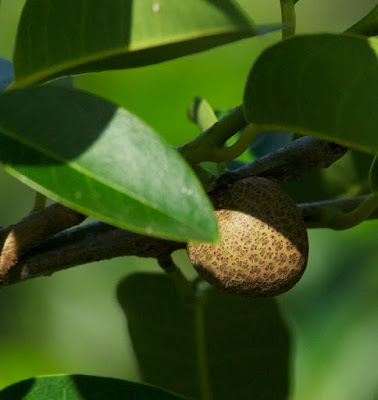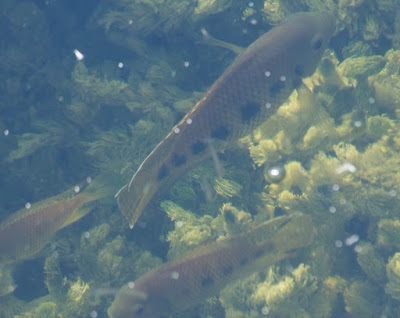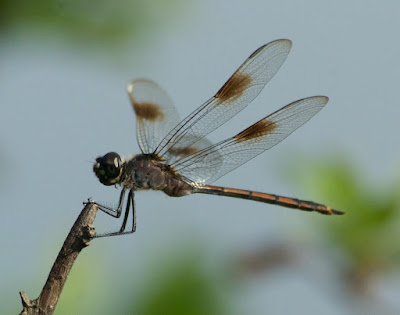We start, then, with a few dragonflies from the more open marshlands at Green Cay and Wakodahatchee in Delray, all photographed in May 2014. This is the ubiquitous Blue Dasher (Pachydiplax longipennis).
Perhaps the most attractive south Florida dragonfly (it actually ranges north to southern Ontario, though I have never seen one there) is the Halloween Pennant (Celithemis eponina). Like the Rhyothemis dragonflies of the Old World, Celithemis species boast heavily-marked, butterfly-like wing patterns; this one is surely named for its orange tint, which recalls (I suppose) a Halloween pumpkin.
The Pin-tailed Pondhawk (Erythemis plebeja) is an easily-recognized Florida specialty (it also ranges from southern Texas to Argentina). It can be rather shy, and that (coupled with its largely black coloration) can make it tricky to get a photo that shows much detail. These, though far from perfect, are some of my better efforts.
Rambur's Forktail (Ischnura ramburii) is the most obvious of the local damselflies. Though it does not reach as far north as the Halloween Pennant, it is a wide-ranging species, found throughout the West Indies and as far south as Chile. This is an adult male. This species, by the way, is named after the same Rambur that gave his name to a common Sarawak dragonfly, Neurothemis ramburii, a species I have often featured here. Jules Pierre Rambur (1801-1870) was a French entomologist who described a great many insects, dragonflies included.
My actual visit to Daggerwing, at least on this trip, was on May 18, 2014. As I mentioned above, though this was once s fig forest it is now dominated by two quite different species. One is a conifer, the Baldcypress (Taxodium distichum) - a tree that has been around in more or less its present form since the days of the dinosaurs. Unlike most conifers, it is deciduous, and these trees are sporting their fresh spring foliage as well as a new generation of cones.
Pond Apple (Annona glabra), on the other hand, is a flowering tree, a member of the custard apple family (Annonaceae).
Like other members of its family, it produces an edible fruit. I have never tried one, but I am particularly fond of its commercially-grown cousins, sweetsop, soursop and custard apple. The Pond Apple fruit bears a definite family resemblance to its tasty relations.
Daggerwing (as its name implies) is particularly devoted to butterflies. Here are two common ones: the White Peacock (Anartia jatrophae)...
...and the Zebra Longwing (Heliconius charithonia). Longwings, of which this is the only Florida example, are fascinating insects. Many tropical species are close mimics of each other, evolving differing mimicry patterns in various parts of their range. They have been the subject of a great deal of research into their behaviour, genetics, evolution and life history (consider this a plug for my book Butterflies, which describes this in more detail), and are popular attractions in butterfly gardens worldwide. Adults, unlike most other butterflies, can take up protein from flower pollen, and may live for many months as a result. Here's a quote from the book:
Daggerwing (as its name implies) is particularly devoted to butterflies. Here are two common ones: the White Peacock (Anartia jatrophae)...
...and the Zebra Longwing (Heliconius charithonia). Longwings, of which this is the only Florida example, are fascinating insects. Many tropical species are close mimics of each other, evolving differing mimicry patterns in various parts of their range. They have been the subject of a great deal of research into their behaviour, genetics, evolution and life history (consider this a plug for my book Butterflies, which describes this in more detail), and are popular attractions in butterfly gardens worldwide. Adults, unlike most other butterflies, can take up protein from flower pollen, and may live for many months as a result. Here's a quote from the book:
"Some male Heliconius longwings are child molesters. In over 40% of Heliconius species, males hunt for female pupae on their larval food plants. They may home in on chemicals released by the chrysalis at the end of her de-velopment. Zebra Longwings (H. charithonia) also search by sight, focusing on plants that show larval damage. In-dividual males perch on and guard any female chrysalis they find, or groups of males may cluster around, waiting for the female to emerge. As soon as she appears, the males jostle each other for position, often copulating with her before she is completely out of her pupal skin. Other species do not wait even that long, breaking into the chrysalis and copulating with the female as soon as they can reach her genitalia. This seemingly abusive behavior may prevent copulation with extremely similar mimics. Where similar species occur together, one may be a pupa molester while the other may not; the difference may lower the likelihood of interspecific mistakes."
The little stream you pass over on the way to the forest is worth a look. You never can tell what might emerge from the pondweed.
Some of what you will see doesn't belong there - hardly a surprise in South Florida, which probably has one of the highest concentrations of alien exotics on the planet. These Spotted Tilapia (Tilapia mariae) properly belong in the waters of West Africa, but they have been swimming in Florida since at least 1974. It has done extremely well, and is now the dominant fish in many areas (probably to the detriment of less aggressive native species).
The Florida Soft-shelled Turtle (Apalone ferox) certainly does belong here - indeed, it is pretty much confined to the American southeast. This seems to be a young animal; the yellow stripes on its head will fade with age.
Finally, here are some actual Daggerwing dragonflies. This is a male Eastern Pondhawk (Erythemis simplicicollis), a wide-ranging species that, like the Blue Dasher, is also common in Ontario.
Needham's Skimmer (Libellula needhami) is s much more restricted-range species, at least in the United States where it is confined to near-coastal areas along the eastern seaboard and the Gulf of Mexico. These are females.
The little stream you pass over on the way to the forest is worth a look. You never can tell what might emerge from the pondweed.
Some of what you will see doesn't belong there - hardly a surprise in South Florida, which probably has one of the highest concentrations of alien exotics on the planet. These Spotted Tilapia (Tilapia mariae) properly belong in the waters of West Africa, but they have been swimming in Florida since at least 1974. It has done extremely well, and is now the dominant fish in many areas (probably to the detriment of less aggressive native species).
The Florida Soft-shelled Turtle (Apalone ferox) certainly does belong here - indeed, it is pretty much confined to the American southeast. This seems to be a young animal; the yellow stripes on its head will fade with age.
Finally, here are some actual Daggerwing dragonflies. This is a male Eastern Pondhawk (Erythemis simplicicollis), a wide-ranging species that, like the Blue Dasher, is also common in Ontario.
Needham's Skimmer (Libellula needhami) is s much more restricted-range species, at least in the United States where it is confined to near-coastal areas along the eastern seaboard and the Gulf of Mexico. These are females.
The dragonfly that caught my eye, though, on my May 2014 visit to Daggerwing was the Four-spotted Pennant (Brachymesia gravida). I have often been to Daggerwing on past Florida visits, though admittedly usually in autumn or winter, but I do not recall seeing it there before.
This time, though, it was not simply present; it was there in swarms, particularly in more open, reedy marshside areas. If I stood with my camera in the right patch of reeds, all I had to do to see one (or lots of them) was look up. According to Dennis Paulson's indespensable Dragonflies and Damselflies of the East, these dragonflies can reach "prodigous densities" on large open lakes. There were certainly a lot of them about.
Females (and immature males) have paler wing patches from males, but share distinctive (and, in the American southeast, unique) white pterostigmas, clearly displayed in these photos.
These individuals are all females.
I have more, and closer, photos of females than of males, probably because when they they perch in a reedbed they tend to stay on the less windy, inshore side (according to Giff Beaton's excellent Dragonflies and Damselflies of Georgia and the Southeast). Males prefer the watery side of the reeds, and fly about more. I'm afraid that, though a dragonfly fancier, I tend to be reluctant to get my feet wet (or to deposit myself, and more particularly my camera, in the mud).






































No comments:
Post a Comment